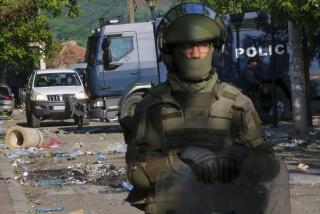Armed Yugoslav Standoff Cools Down : Ethnic rivalry: Croat forces head back to bases after confronting federal troops. But feud with Serbs seems unlikely to be resolved soon.
- Share via
ZAGREB, Yugoslavia — An armed standoff between federal troops and Croatian republic police eased Sunday when Croats left the scene of Yugoslavia’s worst unrest in months. But warning signs abounded that the demon of ethnic violence will not be quickly induced back into its bottle.
While Croatian special forces were headed back to Zagreb from the ethnically mixed town of Pakrac, Croatian militia units intervened elsewhere to prevent nationalist rallies by minority Serbs.
Anti-Croatian demonstrations were staged in several Serbian cities and Serbs living near Pakrac set up barricades to keep the ethnic confrontation from spilling into their communities.
Despite an order by the Yugoslav presidency for all outside forces to leave Pakrac, federal army troops in armored vehicles were reported to be holding their positions.
By refusing to withdraw from Pakrac by midnight Sunday, the soldiers loyal to Belgrade Communists demonstrated how difficult it will be to undo the damage caused by venting age-old hostilities in the present atmosphere of mistrust, uncertainty and fear.
Relations between Yugoslavia’s two largest ethnic groups have degenerated to such a state that few expect the federation to survive until the end of this year. The six republics are now split between Communist and democratic states, as well as by historical, religious, linguistic and cultural factors.
Troops and armored vehicles of the pro-Communist Yugoslav People’s Army on Saturday moved into Pakrac, about 70 miles southeast of Zagreb, on the order of Serbian Marxist Borisav Jovic, who currently heads the collective eight-man federal presidency.
Jovic appeared to have acted unilaterally in dispatching the soldiers. An emergency meeting of the full eight-man presidency countermanded his order a few hours later.
“It is necessary that the forces engaged from outside withdraw . . . within 24 hours,” the federal presidency said in a statement carried by the official news agency Tanjug.
Jovic sent in the troops after Serbs in Pakrac exchanged gunfire with Croatian reservists trying to retake control of local government buildings and the police station, which had been occupied by Serbian militants since Feb. 22.
Tanjug said that Pakrac was calm on Sunday but described the city as tense and nearly deserted. The agency reported the departure of the Croatian reservists just after nightfall, but said that the army tanks and troops remained.
Pakrac has a population of about 30,000, of which nearly 40% are Serbs, 35% are Croats and the rest spread among Yugoslavia’s numerous other ethnic groups.
Serbs account for about 12% of Croatia’s 5 million residents. The sizable minority is mostly assimilated, although about 30% of the Serbs are concentrated in the self-styled independent region of Krajina.
Serbian President Slobodan Milosevic, a hard-line Communist, has said that Serbia will seek annexation of all regions where Serbs live in the event--now seen as unavoidable--that Yugoslavia unravels.
Croatian authorities have accused Milosevic of stirring up ethnic hysteria in Krajina to destabilize the non-Communist government in Zagreb and to give the army a pretext to impose military rule.
Serbian media repeatedly have accused Croatia of plotting to repress, or even exterminate, the minority Serbs in their republic if they gain independence.
Croatia and Slovenia have been forging ahead with plans to secede and to form sovereign, Western-oriented democratic states. Serbia, however, favors maintaining strong central rule over a federation that it has dominated since creation of the Yugoslav state in 1918.
More than 24 hours after Tanjug reported shots fired in Pakrac, casualty reports remained vague and contradictory. Serbian media had reported as many as six dead Saturday but Croatian officials and hospital workers in Pakrac said that there were no fatalities.
Croatian Interior Ministry officials said that three policemen--all Croats--were injured in the clashes that resulted when reservists tried to disarm and disperse Serbian militants.
About 150 Croatian reservists had moved in to Pakrac early Saturday and most had left by nightfall on Sunday, according to Tanjug.
However, other Croatian units blocked roads around the town of Osijek to prevent about 400 ethnic Serbs from attending a nationalist rally. They used tear gas to disperse the crowd that they accused of menacing passersby.
In Belgrade, Milosevic’s ruling Socialist Party drew about 5,000 people to a rally at the confluence of the Danube and Sava rivers in support of Serbs who they claim are being repressed by Croatia.
Serbia’s main opposition political leader, Vuk Draskovic, also addressed a crowd of about 1,500 and vowed that blood would be shed if “one Serb is killed by Croats.”
Serbian demonstrators in Novi Sad, just north of Belgrade, chanted in support of the army action against the “fascist Croatian leadership.”
More to Read
Sign up for Essential California
The most important California stories and recommendations in your inbox every morning.
You may occasionally receive promotional content from the Los Angeles Times.














